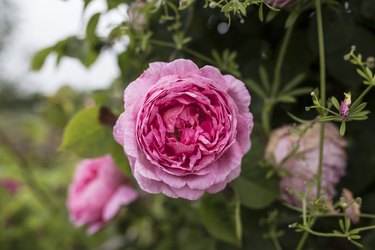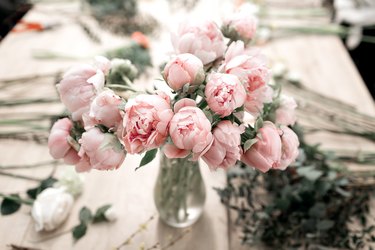
Peonies are perennial plants that produce blossoms in shades of pink, purple, red, white and yellow. The plant does best in an area with full sun or partial shade, and requires cold winter temperatures for maximum flower production and quality. The planting location should be sheltered from harsh weather, have well-drained soil with a neutral to slightly acidic pH. The plants are noted for their large flowers, which will occasionally appear to change color. This apparent flower color change is due to a number of environmental or health-related issues.
Stress May Induce Discoloration
Video of the Day
Slight flower discoloration may occur when the peony plant is moved or transplanted or otherwise stressed. Stress may cause a peony flower to lighten, though the exact cause is not known. Depending on the amount of damage and specific type of plant, the original color may return soon after, a return may take a year or two or may not happen at all. This physical change is most common in iris flowers, though most types of plants will suffer from such color changes. Illnesses, viral infections, droughts or pest infestation often increases the stress level of a plant, which may affect flower color.
Video of the Day
Self-Sowing Hybrids May Revert
Also called self-seeding, a large number of hybridized annuals will return each year, but are grown from seeds instead of roots as with perennials. Because the parent plant is a hybrid, offspring growing from its seeds do not breed true, meaning that the new generation has reverted back and taken on characteristics of an earlier ancestor. These plants will often develop flowers that are different colors than those of the parent plant that produced the seeds. This is the result of genetics, and means that established plants carry genes for different colors, giving the impression that the plant has produced a peony color change.

Some flower species tend to take on a more yellow or white appearance with age. Tulips and gladiolus flowers are the most common color-changing varieties, though most types will fade a bit with age. The exact cause of the age-related color change is not known, though may be a method for indicating overall health to pollinators. Because this type of color change is naturally occurring, the flowers will not change back, instead, growers will have to dig up older plants and replace them with new ones.
Genetic Mutations May Result In Sports
Sporting is a genetic mutation that results in a single flower or branch of flowers which change color. This mutation most often changes just the petal color, but occasionally will also alter leaf color. The reasons behind the changes are not known, and sporting is fairly rare. For a sport to show up, the plant itself would have to be a cutting from a plant with such a mutation.
Light and Temperature

Light is a primary factor in petal color, and if it is in short supply, a paler flower may result. Peonies should be given full sun to partial shade and protected from high winds and harsh conditions. Cool weather may also produce a more intensely colored flower than warm or hot weather.